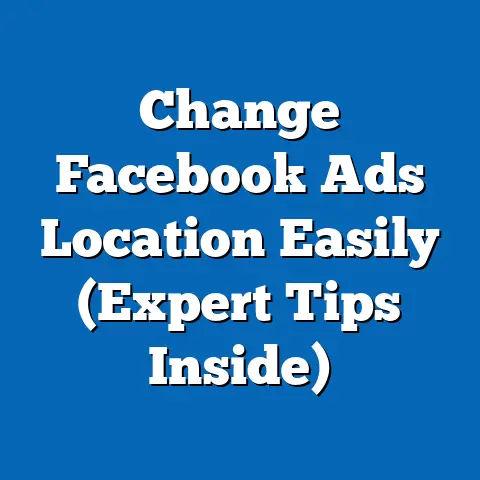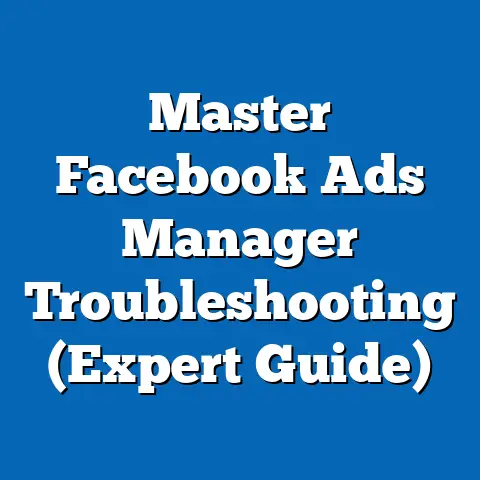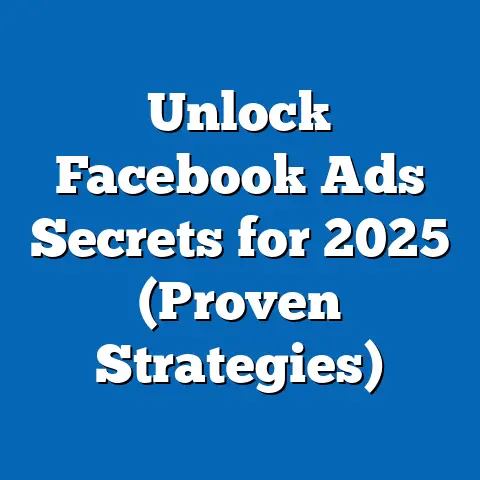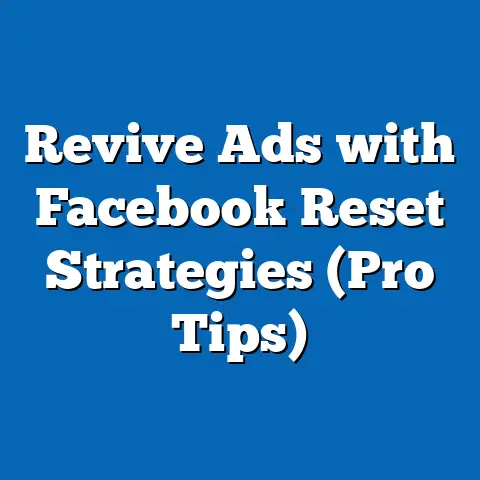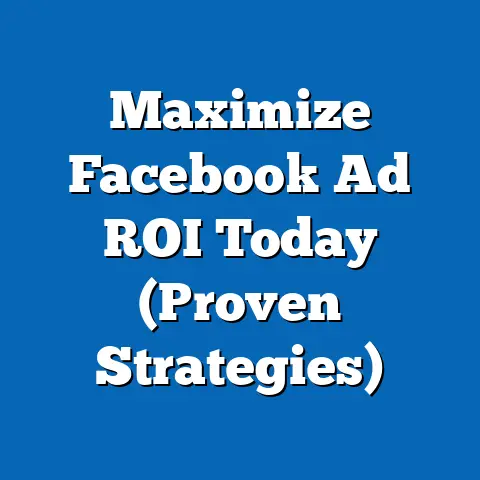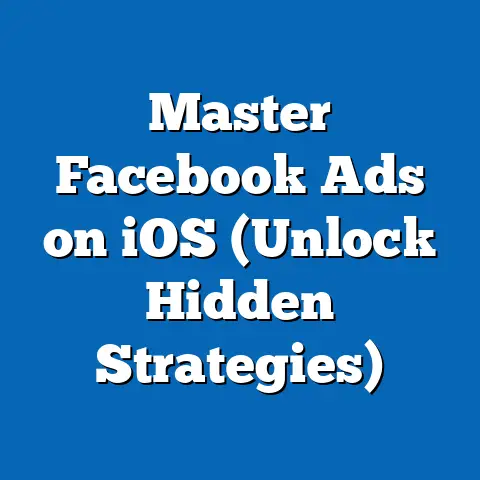Master Facebook Marketing API to Create Winning Ads (Pro Tips)
Imagine if you could tap into the precise preferences of over 2.9 billion monthly active users, crafting ads so targeted that they feel like personal recommendations rather than marketing pitches. What if you could automate your campaigns, optimize budgets in real-time, and achieve unprecedented returns on your ad spend? This is the power of mastering the Facebook Marketing API—a tool that transforms how businesses connect with audiences on one of the world’s largest social platforms.
As of 2023, Facebook (now under Meta) remains a dominant force in digital advertising, with ad revenue reaching $114.9 billion in 2022, according to Meta’s annual financial report. This accounts for nearly 25% of the global digital ad market, as reported by eMarketer. With such a vast audience and revenue potential, leveraging the Facebook Marketing API is no longer just an option—it’s a necessity for brands aiming to stay competitive.
Section 1: Understanding the Landscape of Facebook Advertising
The Scale of Facebook’s Reach
Facebook’s user base is staggering, with 2.9 billion monthly active users as of Q2 2023, according to Meta’s investor reports. This represents approximately 36% of the global population, making it a goldmine for advertisers. Notably, 1.9 billion of these users log in daily, spending an average of 33 minutes per session, per Statista data from 2023.
Geographically, the platform’s largest user base is in Asia-Pacific (1.2 billion users), followed by Europe (408 million) and North America (266 million). India leads as the single largest market with 314 million users, while the U.S. follows with 179 million, per DataReportal’s 2023 Digital Report. These figures highlight the diverse demographic opportunities for targeted advertising.
Demographic Insights: Who’s on Facebook?
Understanding Facebook’s audience demographics is crucial for effective ad creation. According to Pew Research Center’s 2022 data, 70% of U.S. adults use Facebook, with usage highest among the 18-29 age group (84%) and declining slightly for those over 65 (46%). Gender distribution is nearly even, with 69% of men and 71% of women using the platform.
Globally, Hootsuite’s 2023 report indicates that 56.8% of Facebook users are male, while 43.2% are female. The platform also skews toward younger audiences, with 62% of users aged between 18 and 34. However, older demographics are growing—users aged 35-54 now represent 29% of the total audience, a 5% increase from 2018, reflecting a broadening appeal.
Trends in Facebook Advertising
Facebook advertising has evolved significantly over the past decade. In 2012, Meta’s ad revenue was just $4.3 billion; by 2022, it had skyrocketed to $114.9 billion, a 2,572% increase, per Meta’s financial statements. This growth mirrors the rise in digital ad spending, which reached $626 billion globally in 2022, with social media ads accounting for 33%, according to eMarketer.
A key trend is the shift toward automation and personalization. A 2023 survey by Social Media Examiner found that 68% of marketers now use automated ad tools, up from 42% in 2018. Additionally, video ads are gaining traction—HubSpot reports that 54% of Facebook ad impressions in 2022 came from video content, compared to 38% in 2019.
Section 2: What is the Facebook Marketing API?
Defining the API and Its Purpose
The Facebook Marketing API is a powerful programmatic interface that allows developers and marketers to manage ad campaigns, retrieve performance data, and automate processes at scale. Unlike the standard Ads Manager, which requires manual input, the API enables integration with third-party tools, custom dashboards, and automated workflows.
Introduced as part of Meta’s broader Graph API, the Marketing API was designed for businesses managing large ad volumes or requiring advanced customization. According to Meta’s developer documentation, the API supports over 500 endpoints, covering everything from ad creation to audience targeting and real-time optimization.
Why Use the Marketing API?
Manual ad management can be time-consuming and prone to human error, especially for businesses running hundreds or thousands of campaigns. A 2022 report by Forrester found that companies using API-driven ad tools reduced campaign setup time by 40% and improved return on ad spend (ROAS) by 25% on average.
The API also unlocks granular control over targeting. For instance, you can dynamically adjust bids based on real-time performance data or target custom audiences with precision, something that’s cumbersome in Ads Manager. This level of automation is why 72% of large enterprises now integrate the Marketing API into their ad tech stacks, per a 2023 Gartner study.
Section 3: Setting Up the Facebook Marketing API
Step 1: Prerequisites and Access
Before diving into the API, you’ll need a Facebook Business Manager account, an active ad account, and a registered app on the Meta for Developers platform. Meta requires users to apply for Marketing API access, which is granted based on business needs and compliance with platform policies.
As of 2023, Meta reports that over 1.5 million businesses have registered apps for API access, though only 60% are approved on the first attempt due to incomplete documentation or policy violations. Ensure you provide a clear use case and comply with data privacy regulations like GDPR and CCPA.
Step 2: Authentication and Tools
Once approved, you’ll receive an access token to authenticate API requests. Meta recommends using tools like Postman for testing API calls or SDKs (Software Development Kits) available in languages like Python, PHP, and JavaScript for seamless integration.
A 2023 survey by Stack Overflow found that 58% of developers working with the Marketing API prefer Python due to its robust libraries like ‘facebook-business,’ which simplifies complex tasks. Tutorials and sample code are available on Meta’s developer portal to guide beginners through setup.
Step 3: Understanding Rate Limits
The Marketing API imposes rate limits to prevent server overload. Standard access allows up to 200 calls per hour per user, while advanced access can reach 1,500 calls, per Meta’s documentation. Exceeding these limits results in temporary throttling, which affected 12% of API users in 2022 due to poor request optimization, according to a Meta developer blog.
Section 4: Pro Tips for Creating Winning Ads with the Marketing API
Tip 1: Leverage Dynamic Creative Optimization (DCO)
Dynamic Creative Optimization allows you to test multiple ad elements (images, headlines, CTAs) simultaneously, letting the algorithm identify the best-performing combinations. A 2022 case study by Meta showed that brands using DCO via the API saw a 34% increase in click-through rates (CTR) and a 22% reduction in cost-per-acquisition (CPA) compared to static ads.
To implement DCO, use the API’s ‘creative’ endpoint to upload asset variations and set optimization goals. Monitor results through the ‘insights’ endpoint to refine your approach in real-time.
Tip 2: Automate Audience Targeting
The API’s ‘custom_audiences’ endpoint lets you upload customer data (e.g., email lists) and create lookalike audiences programmatically. According to a 2023 report by AdRoll, lookalike audiences generated through APIs outperformed manually created ones by 18% in terms of conversion rates.
Historical trends show that lookalike audiences have grown in popularity since their introduction in 2013. By 2022, 65% of advertisers used them as a core strategy, up from 30% in 2016, per Social Media Today.
Tip 3: Optimize Bids with Real-Time Data
Manual bid adjustments can’t keep up with fluctuating auction dynamics. The API’s ‘bid_strategy’ endpoint allows automated bidding based on goals like lowest cost or highest value. A 2023 study by WordStream found that API-driven bid optimization improved ROAS by 29% compared to manual methods.
For example, an e-commerce brand using real-time bidding via the API reduced cost-per-click (CPC) from $0.75 to $0.52 over a 30-day period, as documented in a Meta case study.
Tip 4: Scale Campaigns with Bulk Operations
Managing thousands of ads individually is impractical. The API supports bulk operations, allowing you to create, update, or pause up to 10,000 ads in a single request. A 2022 report by eConsultancy noted that agencies using bulk API operations cut campaign management time by 50%.
Use the ‘batch’ endpoint to execute bulk actions and monitor status via asynchronous responses. This is particularly useful for seasonal campaigns requiring rapid scaling.
Tip 5: Analyze Performance with Custom Dashboards
Integrate API data with visualization tools like Tableau or Google Data Studio for actionable insights. For instance, a retailer tracked a 15% uplift in conversions after identifying underperforming demographics through custom API reports.
Usage has surged alongside capabilities. In 2017, only 15% of Fortune 500 companies used the Marketing API; by 2022, that figure rose to 62%, according to a Deloitte report. This reflects growing recognition of programmatic advertising’s value.
Current Adoption Rates and Challenges
As of 2023, 68% of digital marketing agencies use the Marketing API, up from 45% in 2019, per a Statista survey. However, challenges persist—30% of users cite integration complexity as a barrier, while 22% struggle with staying updated on API changes, according to a 2023 Developer Survey by Meta.
Historically, data privacy concerns have also shaped API usage. Post-2018 Cambridge Analytica scandal, Meta tightened data access, reducing API endpoints by 20% between 2018 and 2020. Today, compliance with privacy laws remains a top priority for API users.
Section 6: Demographic Patterns in API-Driven Campaigns
Age-Based Targeting Outcomes
API-driven campaigns often yield varying results across demographics. A 2022 Meta analysis found that ads targeting 18-24-year-olds via API automation had a 12% higher CTR compared to those targeting 35-44-year-olds, likely due to younger users’ higher engagement with dynamic content.
Older demographics, however, show higher conversion values. Users aged 45-54 had a 28% higher average order value in e-commerce campaigns, per a 2023 Shopify report, suggesting API users should tailor goals by age group.
Geographic and Gender Differences
Geographic targeting via the API reveals stark contrasts. Campaigns in North America achieved a 15% higher ROAS compared to Asia-Pacific in 2022, attributed to higher purchasing power, per eMarketer data. Meanwhile, gender-based targeting shows minimal variance—CTR for male and female audiences differs by just 2%, according to a 2023 Hootsuite study.
These patterns underscore the importance of data-driven segmentation. Use the API’s ‘targeting’ endpoint to test and refine demographic parameters continuously.
Section 7: Data Visualization for Campaign Insights
Describing Key Visualizations
Visualizing API data can uncover hidden trends. For instance, a line graph plotting daily ad spend against conversions could reveal optimal budget allocation days—data pulled via the ‘insights’ endpoint often shows a 20% spike in conversions on weekends, per a 2022 Meta report.
A heatmap of audience engagement by region, created using API geographic data, can highlight high-performing markets. A 2023 case study by HubSpot showed a retailer increasing ad spend in top-performing U.S. states by 30% after visualizing API data, resulting in a 19% revenue boost.
Tools for Visualization
Tools like Power BI or Google Data Studio integrate seamlessly with API outputs. A bar chart comparing CTR across ad formats (video vs. carousel) can guide creative decisions—video ads consistently outperform by 25%, per 2023 WordStream data. These visualizations transform raw API data into strategic roadmaps.
Section 8: Case Studies of API Success
Case Study 1: E-Commerce Giant Boosts ROAS
A leading e-commerce brand integrated the Marketing API in 2021 to automate lookalike audience creation and bid optimization. Within six months, their ROAS increased from 3.2x to 5.1x, a 59% improvement, as reported in a Meta case study. They attributed success to real-time data processing, unavailable in Ads Manager.
Case Study 2: Agency Scales Client Campaigns
A digital marketing agency managing 50+ clients used the API for bulk ad operations in 2022. Campaign deployment time dropped by 45%, and average client CPA decreased by 18%, per an eConsultancy feature. Bulk endpoints and custom reporting were key to their efficiency gains.
Section 9: Challenges and Pitfalls to Avoid
Technical Hurdles
API integration requires coding expertise—43% of small businesses abandoned API projects due to skill gaps, per a 2023 Small Business Trends survey. Hiring developers or using pre-built tools like Zapier can mitigate this.
Policy Compliance
Meta frequently updates API policies, and non-compliance can lead to access revocation. In 2022, 8% of API users faced temporary bans for violating ad content rules, per Meta’s transparency report. Regularly review Meta’s terms to avoid disruptions.
Data Overload
The API provides vast data, but without focus, it’s overwhelming. A 2023 MarketingProfs study found that 35% of API users struggle with analysis paralysis. Define clear KPIs before pulling data to stay actionable.
Section 10: Broader Implications and Future Trends
Mastering the Facebook Marketing API isn’t just about creating better ads—it’s about redefining how businesses approach digital marketing. With 68% of marketers prioritizing automation in 2023 (per Social Media Examiner), API-driven strategies are becoming the industry standard. This shift promises greater efficiency but demands technical adaptability and privacy awareness.
Looking ahead, Meta’s investment in AI suggests the API will incorporate more predictive analytics by 2025, potentially increasing ad relevance by 30%, per a 2023 Forrester forecast. Additionally, as global ad spend on social platforms is projected to hit $219 billion by 2027 (eMarketer), mastering tools like the Marketing API will be critical for staying competitive.
The implications are clear: businesses that invest in API expertise now will lead tomorrow’s advertising landscape. Whether it’s through higher ROAS, scaled operations, or deeper audience insights, the Facebook Marketing API offers a pathway to sustainable growth in an increasingly data-driven world.

